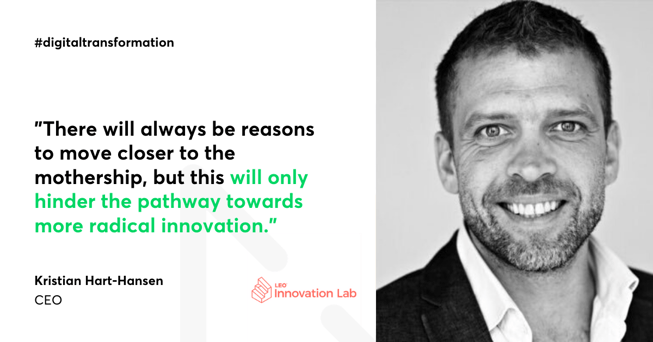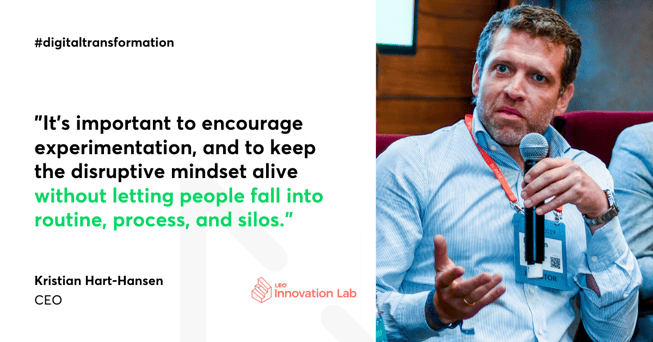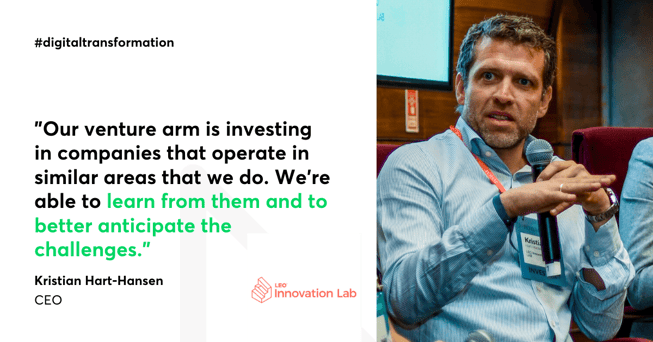Digital Transformation Lesson: “Nobody is Allowed to Say No”. How a Small Unit Became a Leader in its Market

Here’s an excerpt from a recommendation given on LinkedIn to Kristian Hart-Hansen by one of his co-workers.
Hart-Hansen is the CEO and founder of LEO Innovation Lab, the independent innovation unit of LEO Pharma, a century-old Danish pharmaceutical company. The unit has chosen to focus more on patients’ needs, and digital solutions play a key feature in this - the company is working on improving the lives of patients with chronic skin conditions using AI.
Hart-Hansen started out as a health economist, and he’s been in the industry since 2002. Judging by his openness and insights during Netguru’s panel on digital transformation at Web Summit 2019, I feel that the LinkedIn description from earlier does not differ from reality.
At the panel at Web Summit you compared innovators to bacteria. Is that what innovators at enterprises should expect at the start of the digital transformation process?
Allow me to explain. Throughout the years, each company develops its own immune system. In any enterprise such systems comprise of processes, structures, tools, and a lot of other solutions, well known to employees.
With radical innovation, which is a core focus for LEO Innovation Lab, you attempt to change habits, structures or processes at the company. Your purpose is to affect evolution in the immune system of your company. This can lead to you being viewed as a disruptive force within the company, potentially triggering an immune response.
Sounds like this battle is lost before it even begins.
On the contrary. This friction is inherent, the immune system has to react this way, as it was built to protect core activities of the company. Yet being aware of this allows the management team to allocate resources and react adequately.
At LEO Innovation Lab, we have mitigated the potential risks of being seen as bacteria by functioning with a high degree of autonomy. This means we’re not hindered by the immune system of the company, and we can take solutions back to our motherships once we have validated that they can provide value.

What is required for radical innovation, say a shift in the business model?
Any radical change in an organization requires a different kind of talent. We need competencies and team structures that can’t be nurtured within the existing organization.
We have achieved tangible, value-driving innovation by separating everything - location and culture included - therefore avoiding a lot of distraction and frustration, both for the mother organization and the new unit.
And this autonomy has led to success. We’ve been able to achieve great things with our mandate.
We have made progress with improving diagnostic accuracy with AI and in digitizing the clinical trial process. In addition, we’ve spun out several projects that have gone forward to secure millions in external investment and are functioning as successful independent companies.
And it only took a few years for LEO Innovation Lab to become one of the world’s leaders in AI diagnosis of skin conditions.
That’s something I never believed was possible. Our AI-powered diagnostics platform is able to diagnose several skin conditions to the same degree of accuracy as an experienced specialist. This capability has huge implications for improving the efficiency of health systems all over the world.
We’ve also built platforms that are improving the efficiency of the clinical trial process, positing a huge potential for reducing the time-to-market for new treatments, and laying the foundation for new possibilities in precision medicine for those living with skin conditions.
We’re now in a position where the foundation is established and we need to focus on how best to implement our technologies in real-life applications.
This is an exciting step, but there's a long journey ahead. We’re currently exploring clinical partnerships and the regulatory landscape to make sure we can roll-out this technology safely and ethically.

In 2016 you’ve painted pharma as one of the more conservative and risk-averse industries, focused on compliance and accustomed to an innovation process that takes 10 years. What has changed since then?
One of the biggest changes we’ve seen in the past couple of years is an increased awareness of the expectations of modern patients. Patients today have more alternative sources of information available to them if they can’t secure an interaction with their doctor soon enough. When a health issue arises, people expect accurate information quickly, the right diagnosis immediately, and for their doctor to know and anticipate their needs. This type of evolved expectation has rendered the traditional health system model to be archaic.
Pharma companies are taking notice of this and adapting their approach accordingly, but they’re not the only ones. Big tech is also moving into the health field, and this is triggering the will from pharma to move quickly.
I noticed that you are a proponent of corporate venture funds as a way of getting a fresh perspective.
A corporate venture fund is one of the solutions that enterprises should think of. Not only does it allow you to scan the market to observe a new trends, but it also opens up a way more chances to retain a stake in the market.
We believe it’s useful to have more eggs in the basket, so our venture arm is investing in companies that operate in similar areas that we do. As a stakeholder in these companies, we’re able to learn from them and to better anticipate the challenges that are awaiting our projects further down the road.
And what do you see?
We’ve seen some companies operating in similar space navigate some tricky regulatory challenges, as well as challenges around conservatism in the clinical setting. This sparked us to start considering co-development with doctors much earlier on in the development phase of many of our projects.
Regarding the regulatory landscape, we’re paying close attention to this much earlier than some of the companies we’ve seen, so it won’t crop up as an unexpected issue for us later.
We’ve also noticed that some of the companies are actually starting to move a little bit faster, in turn forcing us to figure out ways to improve our processes and solutions.

In your opinion, how can company leaders foster a transformation mindset?
It’s important to encourage experimentation, and to keep the disruptive mindset alive without letting people fall into routine, process, and silos. At LEO Innovation Lab, we have maintained a flat management structure and fluid team boundaries to encourage cross-pollination of ideas and a short distance to power.
We have also nurtured a culture of embracing change. Remaining agile and adaptable is key to enabling innovation.
So team structures are often changed, project directions are often tweaked or pivoted based on user tests, the strategic direction of the organization is often updated to reflect new learnings.
It’s important for us to hire talent that can roll with these changes, embrace the challenges that accompany them, and understand the importance of this pace of change.
And what should they avoid?
We have consistently avoided allowing our autonomy to be compromised. This would destroy the culture of free-thinking and disruption that we have worked so hard to nurture. There will always be reasons to move closer to the mothership, but this will only hinder the pathway towards more radical innovation.
To wrap things up, what would be the single piece of advice on how to drive an actual transformation within a large organization?
If you’re working in a highly-regulated industry, such as healthcare or banking, you need to take into account that it’s difficult to do anything in those areas without pushing the barrier of compliance.
How did you solve it at LEO Innovation Lab?
Nobody is allowed to say no. We have our own compliance team and the mindset there is not to say “no” from the start. Instead, we are constantly trying to figure out solutions that enable us to do things differently and push innovations further.
Kristian Hart-Hanses was one of the guest speakers at Netguru's panel on digital transformation during Web Summit 2019. Click the link below for the recap.
Inside Digital Transformation: Learn key Insights from CEOs and Executives at Web Summit 2019








